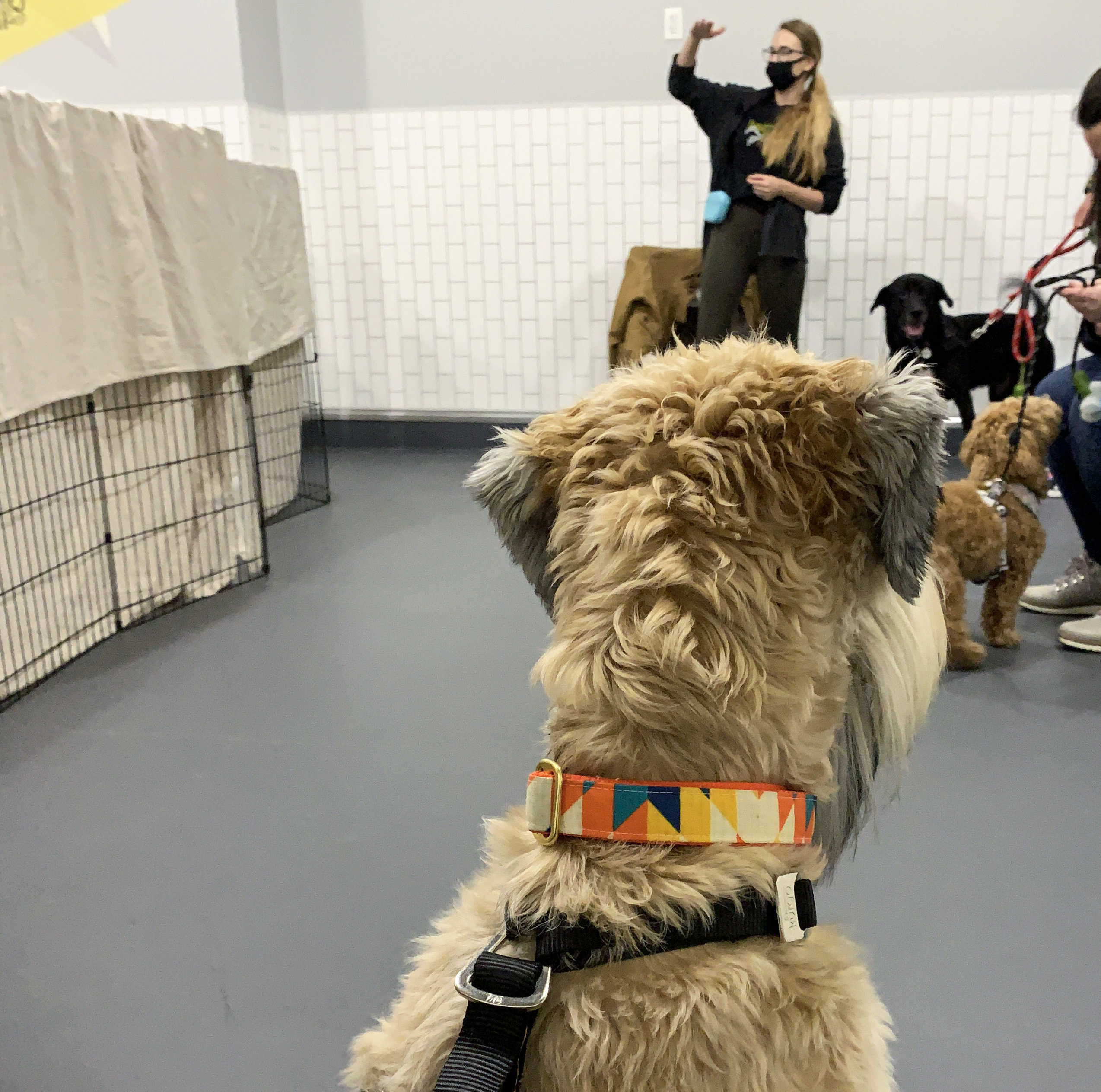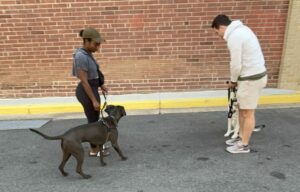This post is written by Alyse Stokes, a freelance writer and longtime partner of District Dogs. The seven-part series will follow her new rescue pup, Nash, as he moves through District Dogs’ six-week Adult Basics training course. Posts will cover each week of the training program plus a follow-up post a few weeks after graduation to see how Nash is doing with his training outside of class.
When we last left my rescue pup, Nash, my husband and I were working to prime him for his first session of Adult Basics at District Dogs. The first week of class is humans-only, and our trainer Carissa gave us the homework of teaching Nash to associate a specific word or phrase with tangible rewards—i.e., treats. This was going to be the same phrase we used to mark his desired behaviors in the classroom, in Nash’s case, “Yes! Good boy!”
Carissa’s tips and advice from Week One of class proved invaluable at home, and Nash quickly got to the point where every time he heard “Yes! Good Boy!” he eagerly looked to us for a treat. I loaded him into the car for Week Two of class and his first visit to District Dogs Shaw with high hopes, excited but unsure of how he would handle the stimulation of a classroom with six other dogs and humans.
Week Two: In the Classroom
Remember in the first post when I said getting a new dog is always an adventure? Well, Nash delivered on the promise of no dull moments by peeing in the car our way to class… not exactly an encouraging start to his first training session. (Thank goodness for protective seat covers!) Arriving at District Dogs a bit frazzled and with a urine-soaked leash, I was grateful for Carissa’s calm and comforting energy. She provided me with an extra (dry!) leash to use for class, and Nash and I settled into our spot in the training room.
Our class of six dogs and their owners was split into two sections with a divider between the two halves of our classroom. This was a big help since it meant Nash was only seeing two other dogs at a time. The training room is a much more distracting environment than most dogs experience at home. That’s actually a huge bonus when teaching commands that need to succeed in any kind of environment. It does take few extra tries in the training room because Nash is so curious about the other pups and humans. However, I know if I can get him to focus and learn a command in the classroom, then there’s a better chance he’ll be able to repeat the desired behavior when he’s excited by being on a walk or in the elevator with another dog.
Our curriculum for Week Two was a great match for Nash’s struggles with focus and impulse control. We covered some basics like “Sit” and “Down” that he was already familiar with (although his success rate pre-class was far from 100%). Crucially, Carissa’s Week Two class plan strongly emphasized training Nash to focus on me no matter what other distractions were present.
Using three levels of treats—basic training treats, more exciting jerky treats, and OMG-super-yummy-give-it-to-me-now high value cheese—our first command was a simple “Look at me.” Carissa guided us on using the lure method to guide our pups into making eye contact, eventually working towards a simple hand motion and voice command to gain Nash’s attention. Having different levels of treats on hand was crucial since Nash easily lost focus with so many interesting sounds, sights, and smells in the classroom.
Our next command made good use of the high value treats as well, harnessing a pup’s keen sense of smell to encourage Nash to “Touch” my open palm. By scenting my hands with irresistible cheese, I was able to show Nash my open palm and have him walk straight towards me, “booping” my hand with his nose. Carissa guided us through various progressions of this command, teaching our pups to respond to alternate hands, various distances, and to “Touch” while walking.
One of the last commands we worked on was a godsend for anyone who’s tried to harness a wriggling, excited pup for a walk. Carissa provided slip leashes and, returning to the lure method, I began teaching Nash to “Get Ready” by placing his head through the opening in the slip leash in return for a treat. By gradually making the opening smaller, I was able to mimic the opening in his harness and watch proudly as he popped his head right through.
Finally, our training class ended with some off leash play time for the pups. By having owners hold their dogs and let them all go at the same time, Carissa created a safe environment for play. Given his challenges with playing too rough and his lack of early socialization, I was excited for Nash to get the chance to interact with a small group of dogs and learn some appropriate play manners.
He did well for the first few minutes, greeting and sniffing the other pups with a happily wagging tail. Unfortunately, he found a stash of treats on the floor and displayed some resource guarding behavior. Carissa gently redirected him away from the treats once, but he couldn’t shake the impulse to guard the spot on the floor where he’d previously found the treats. Ultimately, we ended up spending the remainder of play time in the training room entryway behind the gate to enter the main training space. Like the penalty box in hockey, this space let us see and hear the action—and any of Carissa’s tips on play behavior—while Nash took a little time out from dog-on-dog play.
As a dog owner, it’s easy to get discouraged and embarrassed by those kinds of incidents. However, I’m grateful it happened in the safe environment of the training room with a professional trainer on hand for guidance. Many owners don’t see these behaviors in their dog until an incident occurs at a dog park, and that’s one of the reasons why basic obedience classes are so useful. Aside from knowing when and how to intervene, Carissa provided a resource guarding guide for me to take home and additional tips on how to deal with Nash’s specific guarding behaviors/triggers. It was also nice to have her reassurance that this is a common behavior… especially for dogs like Nash who had food insecurity in their past. No matter how experienced or confident a dog owner might be, being reminded that your dog isn’t alone in their challenges is helpful.
Week Two: At Home
Back home, the classroom practice helped Nash improve his performance on commands like “Sit” and “Down”. Even more valuable were the commands designed to get him to focus. Using “Look at Me” or “Touch” quickly became a vital strategy for managing his impulse control.
Whether he was barking at a noise in the hallway or playing a little too rough with our other dog, “Touch” proved a useful way to redirect his attention. In class, Carissa had also suggested using this command to keep Nash close to me on walks. By placing my open palm down next to my thigh and saying “Touch”, I can easily get Nash to come right next to me. This is a big help when we see other dogs outside or when I need to guide him past something interesting or frightening—e.g., the snowblower he wanted to bark at or the (apparently) scary toolbox on the floor of our hallway which he refused to walk past.
The “Get Ready” command paid immediate dividends too. My husband does our early morning and late-night dog walks, and he greatly appreciated not having to wrestle the harness onto Nash while wearing winter gloves and a big coat… not to mention having to leash and harness a second dog as well. Nash now happily pops his head into the opening of his harness when we say, “Get Ready”. In fact, it’s become easier to get him leashed up for a walk than it is our seven-year-old pup Molly.
Finally, Carissa told our class that it’s important to notice and manage our dogs’ excitement levels. She shared that, unchecked, it’s easy for a dog’s excitement to snowball and keep ratcheting up until they’re over-stimulated. For a dog who struggles with impulse control and resource guarding like Nash, this is especially important because his level of excitement is directly correlated to his propensity for guarding behaviors or overly rough play. Aside from simply getting a hold of him and making him sit quietly with us until he calms down, Carissa also suggested using a quick session of training work to calm him down while keeping him mentally engaged.
Several times throughout the week, I noticed him getting too worked up and was able to redirect that energy into a positive training session. By grabbing his treat pouch, using the “Touch” command to get him to come close to me, and practicing various commands for 10-15 minutes, I could help Nash slowly wind down without having to grab him and force him to be still.
I’m encouraged by the progress we’ve made so far and looking forward to adding more skills to our training sessions. There are few things as rewarding as watching your dog master a new skill, and our Adult Basics training class at District Dogs has given me countless tools as I work to help Nash grow into a happy and well-mannered dog. Check back soon for our Week Three recap!



